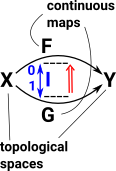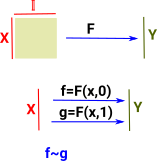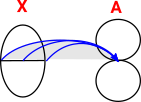Here we discuss continuous mappings between topological spaces.
| For example, the continuous 'rubber geometry' deformations as between a toroid and a mug. |  |
Map from Interval
Start by thinking of the interval as a continuous line segment from 0 to 1. So a map from I represents all possible values between X and Y. A homotopy is a higher level map between two maps. |
 |
Homotopy
 |
If we have two topological spaces X & Y with two continuous maps between them F & G then a homotopy is a continuous map between F & G. In order to see how this is related to the map between the cup and torus I have drawn a map from a third shape (in this case another torus). So as F continuously maps the G then the cup maps to the torus. |
We can move the continuous map forward from the functions to the domain so the functions are homotopic if:
where:
We can think of this as 'filling in' the gap between F and G so that we can take any path through it. |
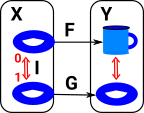 |
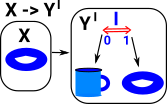 |
Or we can draw it in the codomain (currying) so that each element in X maps to I->Y. |
More about homotopy on page here.
Homotopy Equivalence
If we continuously map every point in X to a point in Y and require an inverse map which brings the point back to where it started and do this in both directions we get a homeomorphism. But if we want a homotopy equivalence (shapes which can be continuously deformed into each other) then we only need a weaker requirement that this round trip and the identity maps are a homotopy. |
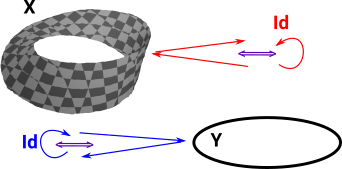 |
More about homotopy equivalence on the page here.
There is a good video about this on a site here.
Fibrations and Cofibrations
A continuous map (homotopy equivalence) can be decomposed into 3 types of continuous map: weak equivalences, fibrations and cofibrations. This is very similar to the way sets can be decomposed into bijections, surjections and inclusions.
What does a continuous mapping look like?
| A continuous mapping may collapse multiple points to single points. |  |
| Here we convert that to neigbourhoods. |  |
 |
So this looks like a fibre bundle as discussed on the page here.
Counter Examples
 |
|
 |
Examples - Möbius Band to Circle
| Here we have a morphism which collapses the width of the Möbius band. |  |
| when we reverse this morphism we keep the global structure and loose some local structure. We also loose the twist in the Möbius band. |  |
Examples - Helix to Circle
| Here we have a morphism which collapses a helix to a circle. |  |
 |
Homeomorphisms
A homeomorphism preserves 'nearness' but allows 'rubber geometry' deformations. Note: homeomorphism is a different concept from homomorphism. |
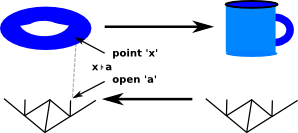 |
Projections
| We can project helix onto circle and still keep continuity. | 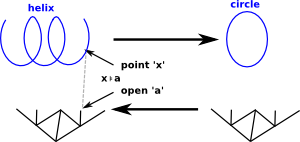 |
Homotopy Extension Property (HEP)
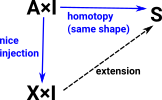 |
Given a homotopy of maps from A to S and an injection from A into a bigger space X (A is a subspace of X) |
Example for showing open sets mapping in the opposite direction. |
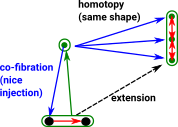 |
This is the inverse of the lift property.
For more about the extension property see the page here.
| Lets consider mapping f0 from a topological space X to a topological space Y. How can we determine if this mapping is a continuous mapping? We have already seen a possible answer to this above (f0 : X->Y is continuous if f0-1(V) is open for every open set V in Y). There are other ways to determine this if we don't have details of open sets. |  |
 |
Here is a example, its obvious just by looking at it that this map is continuous, we can just deform X to get Y (its got the same number of holes) but some maps may not be continuous and it may not be obvious. So we need to formalise it. |
| Sometimes we have an additional piece of information. That is that there is a subset of X called A, this has a map into Y that is known to be continuous, this is f0 restricted to A denoted: f0|A . So the question is: when can this continuous map be extended to the whole of f0 ? |  |
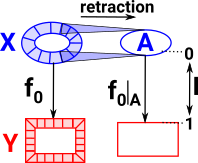 |
To be sure to map to Y can be extended the map from X to its subset A must be a retraction. A retraction is a surjective map that is continuous. This ensures that A has the same number of holes as X. |
This diagram is intended to show the homotopy and the mappings along the interval. To do this the topologies X, A and Y are shown as some sort of one dimensional projection. So the whole mapping is shown as X×I starting at X×{0} and mapping to Y at X×{1}. |
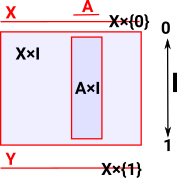 |
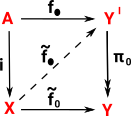 |
This is often illustrated in terms of category theory diagrams (for instance wiki here). This diagram is rotated compared to the diagrams above. Here the map from the interval is curried. So YI is all the maps out of the interval I->Y. Instead of having X×I -> Y we have |
There is a good video about this on a site here.
HEP and Topos Theory
Relationship to topos theory.
| If we look again at the category theory diagram for the HEP. |  |
and then compare it to the diagram for the sub-object classifier (see page here) we can see that there is a similar thing going on: In the Topos case there may not be a requirement for continuous mappings but S is a subobject of X and the mapping between them is injective. |
 |
HEP and Kan Extensions
Relationship to Kan extensions.
| Starting again at the category theory diagram for the HEP. |  |
| Compare it with the diagram for the Kan extension (see page here). The HEP appears to be a special case of the Kan extension (most things are!) so, in this diagram, 'F' is a constant mapping and 'K' is injective. | 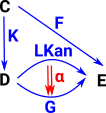 |
| In order to make F constant we factor it through the terminal object. | 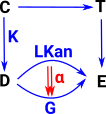 |
Next
see pages about:










